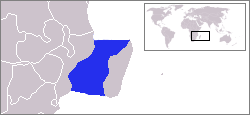Mozambique Channel
| Mozambique Channel | |
|---|---|
 Location of Mozambique Channel | |
| Coordinates | 18°S 41°E / 18°S 41°E |
| Type | Arm |
| Part of | Indian Ocean |
| Basin countries | Madagascar and Mozambique |
| Max. length | 1,600 km (990 mi) |
| Max. width | 1,000 km (620 mi) |
| Min. width | 419 km (260 mi) |
| Surface area | 700,000 km2 (270,000 sq mi) |
| Max. depth | 3,292 m (10,801 ft) |
The Mozambique Channel (French: Canal du Mozambique, Malagasy: Lakandranon'i Mozambika, Portuguese: Canal de Moçambique) is an arm of the Indian Ocean located between the Southeast African countries of Madagascar and Mozambique. The channel is about 1,700 km (900 nmi; 1,100 mi) long and 419 km (226 nmi; 260 mi) across at its narrowest point, and reaches a depth of 3,292 m (10,801 ft) about 230 km (124 nmi; 143 mi) off the coast of Mozambique. A warm current, the Mozambique Current, flows in a southward direction in the channel, leading into the Agulhas Current off the east coast of Southern Africa.[1]
Extent
The International Hydrographic Organization (IHO) defines the limits of the Mozambique Channel as follows:[2]
- On the North. A line from the estuary of the River Rovuma (10°28′S 40°26′E / 10.467°S 40.433°E) to Ras Habu, the northernmost point of Ile Grande Comore, the northernmost of the Comore (Comoro) Islands, to Cap d'Ambre (Cape Amber), the northern extremity of Madagascar (11°57′S 49°17′E / 11.950°S 49.283°E).
- On the East. The west coast of Madagascar.
- On the South. A line from Ponto do Ouro on the mainland (26°53′S 32°56′E / 26.883°S 32.933°E).
- On the South. A line from
- On the West. The coast of Southern Africa.
Islands in the channel
Comoros
France
- )
- Scattered Islands in the Indian Ocean, district of French Southern and Antarctic Lands:
- Glorioso Islands (claimed by Madagascar and Comoros)
- Juan de Nova Island (claimed by Madagascar)
- Europa Island (claimed by Madagascar)
- Bassas da India (claimed by Madagascar)
Mozambique
History
World War II
Graf Spee Incident
On 15 November 1939, under the command of
Having stopped the Africa Shell, a cutter with a boarding party was despatched from the Graf Spee and subsequently boarded the tanker, the officer in charge addressing Captain Dove in perfect English with the sentence: "Good morning, captain. Sorry; fortunes of war."[4]
In time, the boarding party ordered the
With the crew of the Africa Shell making their way to the shore, and with Capt. Dove transferred to the Graf Spee, the boarding party proceeded to set about the operation of sinking the tanker.
Battle of Madagascar
In 1942, the Mozambique Channel was a World War II clashpoint during the Battle of Madagascar.
References
- ^ "Mozambique Channel". Encyclopædia Britannica. Encyclopædia Britannica Inc. 2015. Retrieved 27 September 2015.
- ^ "Limits of Oceans and Seas, 3rd edition" (PDF). International Hydrographic Organization. 1953. Archived from the original (PDF) on 8 October 2011. Retrieved 28 December 2020.
- ^ a b "MV Africa Shell (1939)". Wrecksite. Retrieved 29 December 2020.
- ^ a b c "Motor Vessel AFRICA SHELL built by George Brown & Co. (Marine) Ltd in 1939 for Shell Company of East Africa Ltd. - Anglo-Saxon Petroleum Co. Ltd., London, Tanker". clydeships.co.uk.
- ^ a b Dove, Captain Patrick (1 January 1940). "I WAS GRAF SPEE'S PRISONER!". Withy Grove Press – via Amazon.
- ^ a b "I Was There! - Our Ships were Sunk by the 'Graf Spee' - The War Illustrated". thewarillustrated.info.
External links
- Japanese Submarines at Madagascar and the Mozambique Channel
- Beach, Chandler B., ed. (1914). . . Chicago: F. E. Compton and Co.

